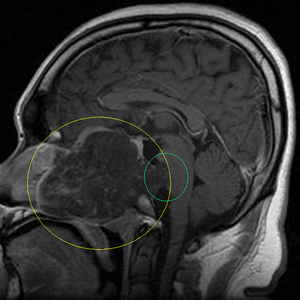Talk:Chordoma
Jump to navigation
Jump to search
Initial remarks
Hi Daniel, I added a little from the top of my head. This is one of those rare ones that we chiropractors do have to watch for, especially with low back pain and headaches. Good start! D. Matt Innis 13:44, 14 May 2010 (UTC)
- Matt, could you add any more about the radiotherapy? Stereotactic gamma knife?
- Daniel, just to clarify: the neoplasm does not touch the actual spinal cord, correct? Incidentally, some circles or arrows on the MRI would help. Howard C. Berkowitz 15:20, 14 May 2010 (UTC)
- Howard, I don't have anything to reference concerning radiotherapy in my office, but I might be able to see what I can get elsewhere. Meanwhile, just FYI, the yellow circle is the chordoma. The green shows that it does appear to be approaching or eminating from the pons which would be unusual. As far as I know, it is usually mostly in the boney structures around the spinal cord.
- Thanks for the circles, Matt — I've replaced the old image with your version. Yes, the origin of these tumours is in the bony tissue, but for this one, they say it had "dural involvement" and, a little later, "a small dural tear at the level of the upper clivus where invasion was maximum". So to the extent that the dura "touches" the spinal cord, so did this tumour. They also seemed tohave achieved complete resection, which is an example of why this edit on cranial base surgery will have to be rephrased. Anyway thanks for chiming in to both of you, and I hope to see more of it. If you have 20min time somewhen in between, I recommend watching the video. --Daniel Mietchen 20:54, 14 May 2010 (UTC)
- Sure, and I undid the surgical edit. D. Matt Innis 22:11, 14 May 2010 (UTC)
- For the therapy section: Treatments Options — at least some drugs achieve partial response or static disease. --Daniel Mietchen 00:24, 16 May 2010 (UTC)
